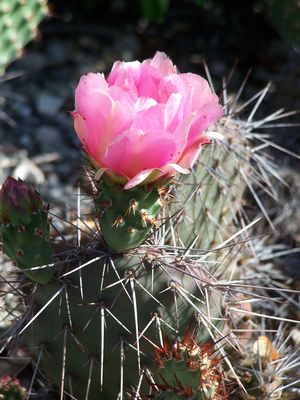View All Plants :: View All ARID LAND PLANTS :: View All SUN PERENNIALS
Opuntia sp. 'Purple Desert'
Beaver Tail Cactus
Plant Type:
ARID LAND PLANTSOpuntia sp. ‘Purple Desert’ (Claude Barr) – This is a “beaver tail” cactus whose blue-green pads turn rich violet-purple when temperatures cool. This Claude Barr selection has fended for itself in our cactus garden and has not been bothered by any of the fungal blights which have obliterated other large-padded neighbors. We do not know the exact species though it may be an O. polyacantha selection. ‘Purple Desert’ sports silvery white spines. Medium-pink, it flowers in early summer. We do not know where Claude Barr discovered this selection but it may have been the central U.S. Plains. Our cacti are potted in our 3.5-inch square size. Cutiing grown.
Characteristics and Attributes for Opuntia sp. 'Purple Desert'
Season of Interest (Flowering)
- Late Spring
Season of Interest (Foliage)
- Four Seasons
Autumn Interest
- Autumn Leaf Color
Nature Attraction
- Deer Resistant
- Honey Bees & Native Bees
Light
- Full Sun
Attributes
- Drought Tolerant
- Evergreen
- Potted Plant
- Rock Garden
- Specimen
- Accent
Growth Rate in the Garden
- Medium
Soil
- Sandy
- Draining
- Calcareous
- Impoverished
- Scrabbled
Propagated By
- Division
- Bare Root
Genus Overview: Cacti
Common Name: Cactus
All cacti are architectonic naturals settled into a stone and gravel garden. Hardy cacti require full sun in very well-drained conditions – this is especially true when planted in the damp, humid eastern U.S. John Spain, guru to cacti growers in New England and beyond, has amended his growing mix to 90% sand and crushed stone to 10% good compost. Raised beds or planting on a south-facing slope are very helpful; low lying areas that hold onto moisture between rains are an anathema to cacti culture. In that there are fungi that can ravage colonies we are offering cultivars that have been completely or relatively disease-free in northeastern Connecticut. Beware the glochids!!! Those are the nexi where the spines emerge. Handle all with care for even those that are spineless can inflict little fiber optic-like hairs which when stuck in the skin may drive you crazy for as long as a week! When cleaning up or propagating I arm myself with my handy Felco pruners in one hand and pliers in the other – for all you classic 50s sci-fi buffs, a modern day Robby the Robot!


